Taxation Law Individual Assignment: Analysis of CGT and Depreciation
VerifiedAdded on 2022/11/11
|7
|2385
|195
Homework Assignment
AI Summary
This individual assignment in Taxation Law analyzes two key areas: Capital Gains Tax (CGT) and depreciation. The first part of the assignment focuses on Jasmine, a UK-born Australian resident, and her tax liabilities upon selling various assets, including a home, car, business assets, furniture, and a painting collection. The analysis applies relevant sections of the ITAA 1936 and ITAA 1997 to determine CGT implications, considering exemptions for main residences, cars, small business concessions, and collectables. The second part addresses the depreciation of a CNC machine purchased by John for his manufacturing company. The analysis explores the cost components eligible for capital allowances, including the machine's purchase price and inspection costs, while excluding installation and additional improvement expenses. It also determines the commencement date for calculating depreciation based on when the machine was first put to use in the business, emphasizing the application of Uniform Capital Allowances (UCA) rules and relevant ATO guidelines.
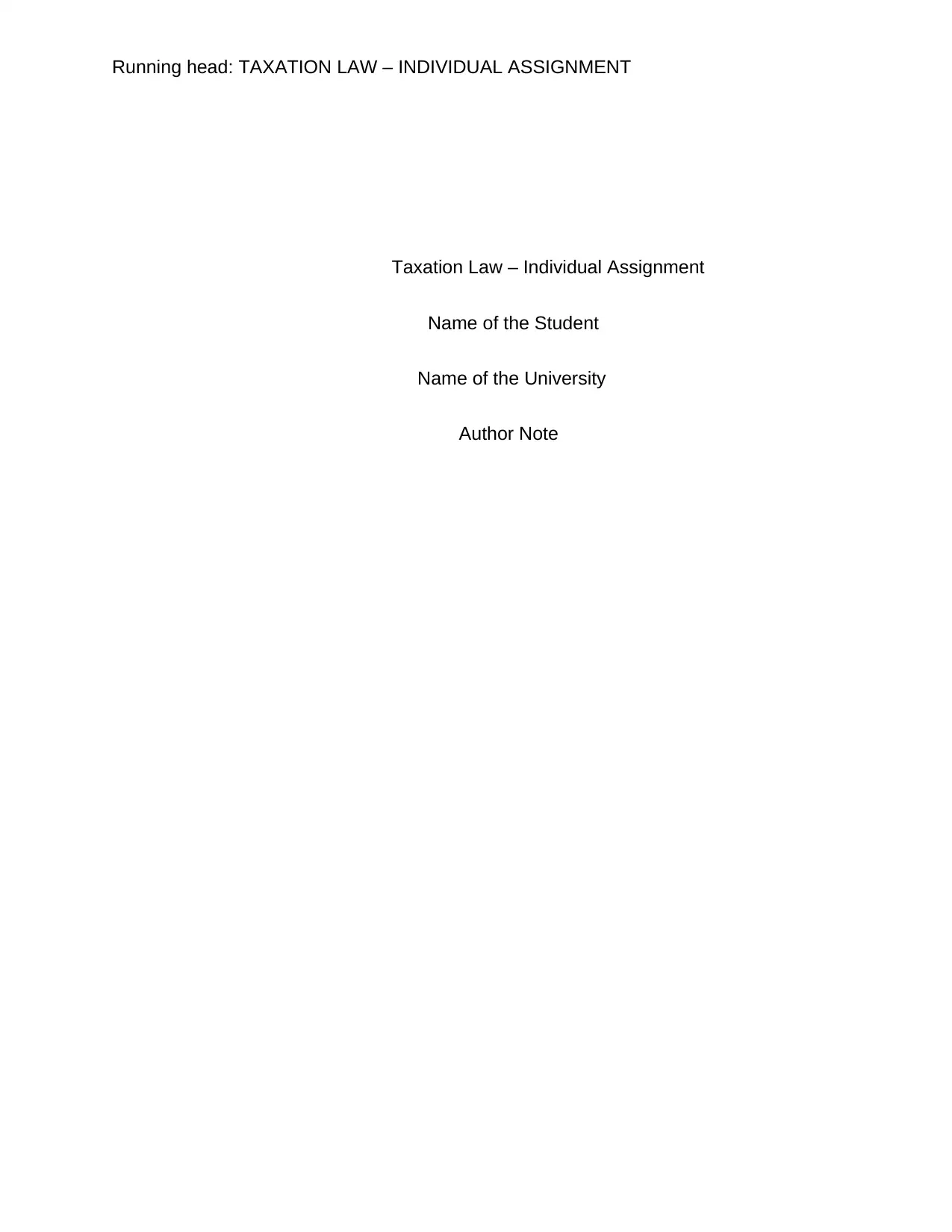
Running head: TAXATION LAW – INDIVIDUAL ASSIGNMENT
Taxation Law – Individual Assignment
Name of the Student
Name of the University
Author Note
Taxation Law – Individual Assignment
Name of the Student
Name of the University
Author Note
Paraphrase This Document
Need a fresh take? Get an instant paraphrase of this document with our AI Paraphraser
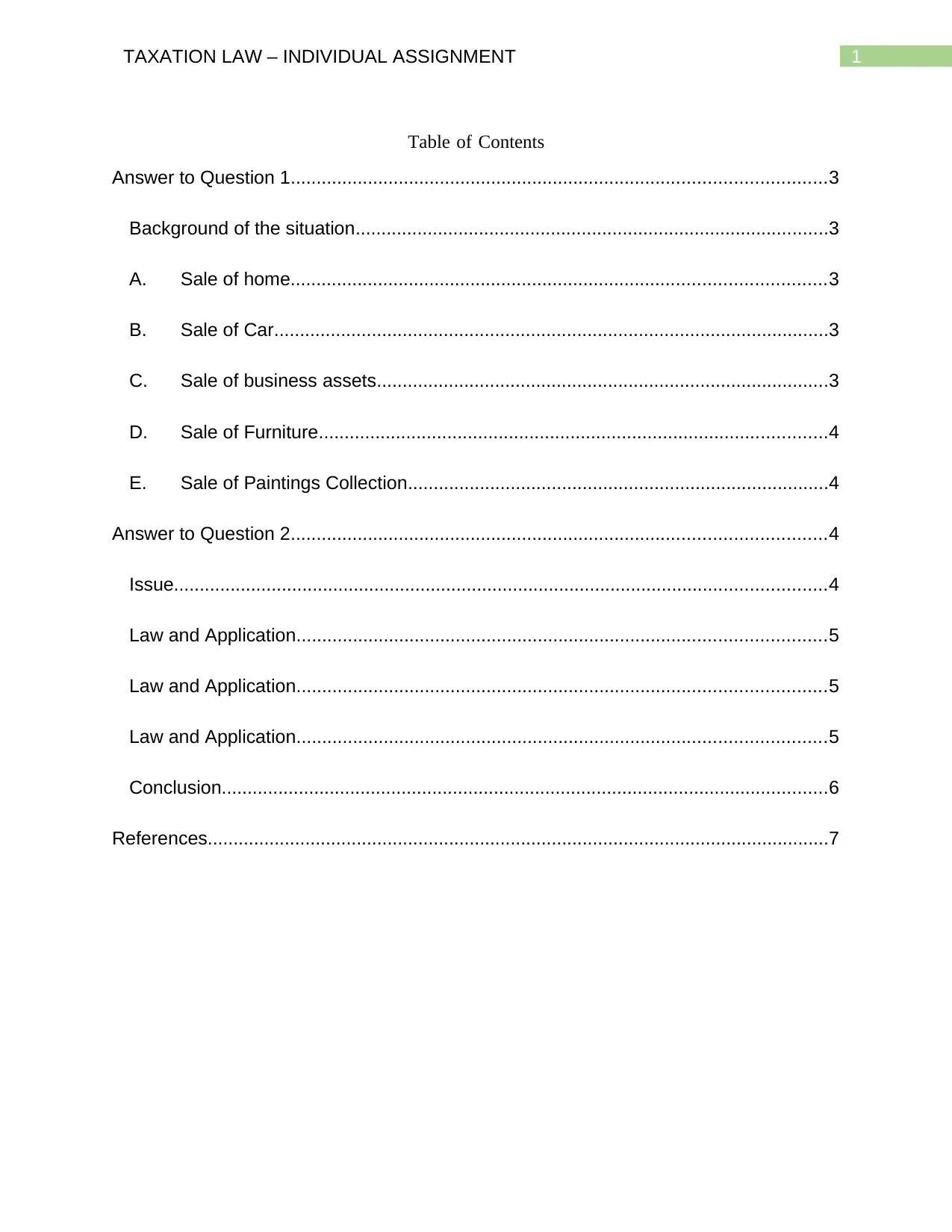
1TAXATION LAW – INDIVIDUAL ASSIGNMENT
Table of Contents
Answer to Question 1........................................................................................................3
Background of the situation............................................................................................3
A. Sale of home........................................................................................................3
B. Sale of Car............................................................................................................3
C. Sale of business assets........................................................................................3
D. Sale of Furniture...................................................................................................4
E. Sale of Paintings Collection..................................................................................4
Answer to Question 2........................................................................................................4
Issue...............................................................................................................................4
Law and Application.......................................................................................................5
Law and Application.......................................................................................................5
Law and Application.......................................................................................................5
Conclusion......................................................................................................................6
References.........................................................................................................................7
Table of Contents
Answer to Question 1........................................................................................................3
Background of the situation............................................................................................3
A. Sale of home........................................................................................................3
B. Sale of Car............................................................................................................3
C. Sale of business assets........................................................................................3
D. Sale of Furniture...................................................................................................4
E. Sale of Paintings Collection..................................................................................4
Answer to Question 2........................................................................................................4
Issue...............................................................................................................................4
Law and Application.......................................................................................................5
Law and Application.......................................................................................................5
Law and Application.......................................................................................................5
Conclusion......................................................................................................................6
References.........................................................................................................................7
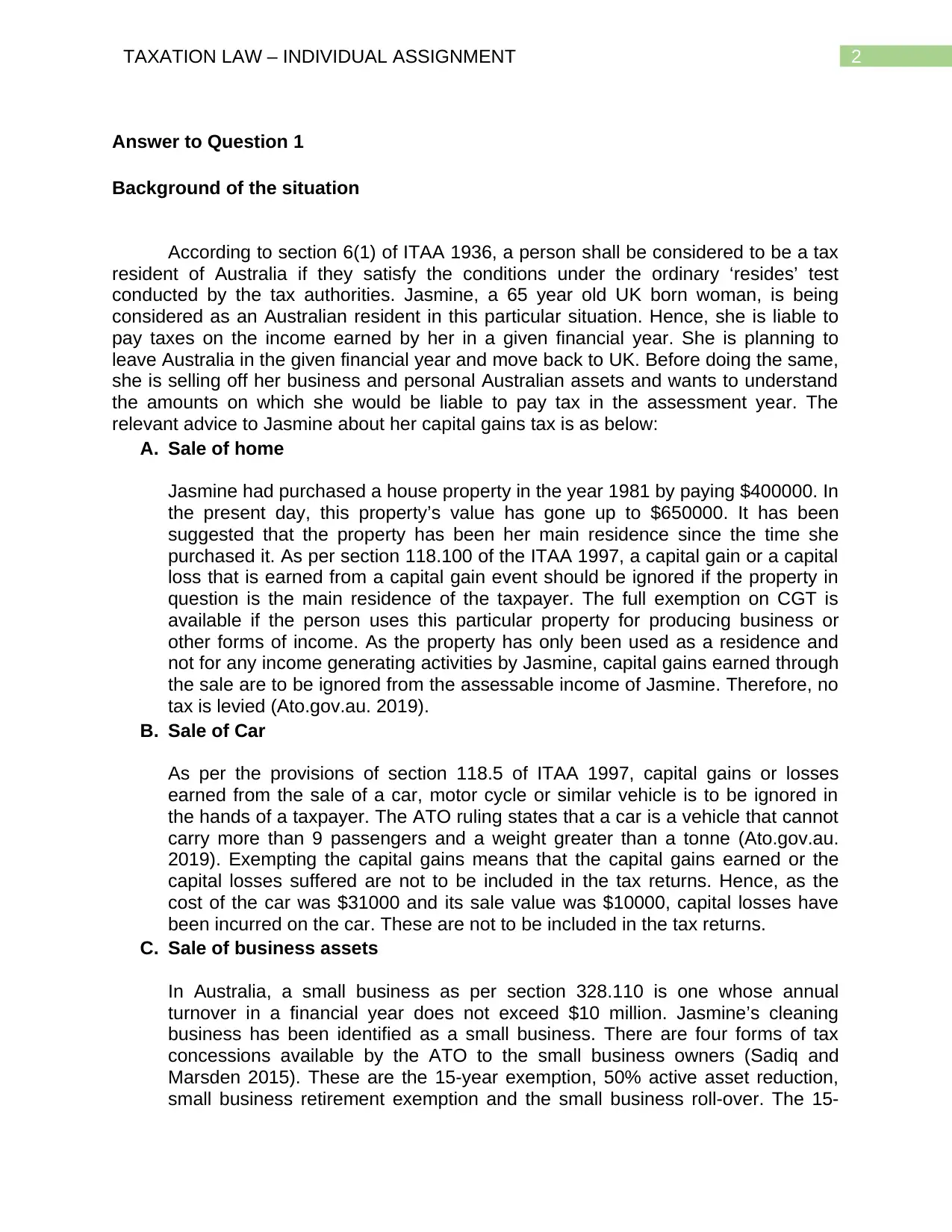
2TAXATION LAW – INDIVIDUAL ASSIGNMENT
Answer to Question 1
Background of the situation
According to section 6(1) of ITAA 1936, a person shall be considered to be a tax
resident of Australia if they satisfy the conditions under the ordinary ‘resides’ test
conducted by the tax authorities. Jasmine, a 65 year old UK born woman, is being
considered as an Australian resident in this particular situation. Hence, she is liable to
pay taxes on the income earned by her in a given financial year. She is planning to
leave Australia in the given financial year and move back to UK. Before doing the same,
she is selling off her business and personal Australian assets and wants to understand
the amounts on which she would be liable to pay tax in the assessment year. The
relevant advice to Jasmine about her capital gains tax is as below:
A. Sale of home
Jasmine had purchased a house property in the year 1981 by paying $400000. In
the present day, this property’s value has gone up to $650000. It has been
suggested that the property has been her main residence since the time she
purchased it. As per section 118.100 of the ITAA 1997, a capital gain or a capital
loss that is earned from a capital gain event should be ignored if the property in
question is the main residence of the taxpayer. The full exemption on CGT is
available if the person uses this particular property for producing business or
other forms of income. As the property has only been used as a residence and
not for any income generating activities by Jasmine, capital gains earned through
the sale are to be ignored from the assessable income of Jasmine. Therefore, no
tax is levied (Ato.gov.au. 2019).
B. Sale of Car
As per the provisions of section 118.5 of ITAA 1997, capital gains or losses
earned from the sale of a car, motor cycle or similar vehicle is to be ignored in
the hands of a taxpayer. The ATO ruling states that a car is a vehicle that cannot
carry more than 9 passengers and a weight greater than a tonne (Ato.gov.au.
2019). Exempting the capital gains means that the capital gains earned or the
capital losses suffered are not to be included in the tax returns. Hence, as the
cost of the car was $31000 and its sale value was $10000, capital losses have
been incurred on the car. These are not to be included in the tax returns.
C. Sale of business assets
In Australia, a small business as per section 328.110 is one whose annual
turnover in a financial year does not exceed $10 million. Jasmine’s cleaning
business has been identified as a small business. There are four forms of tax
concessions available by the ATO to the small business owners (Sadiq and
Marsden 2015). These are the 15-year exemption, 50% active asset reduction,
small business retirement exemption and the small business roll-over. The 15-
Answer to Question 1
Background of the situation
According to section 6(1) of ITAA 1936, a person shall be considered to be a tax
resident of Australia if they satisfy the conditions under the ordinary ‘resides’ test
conducted by the tax authorities. Jasmine, a 65 year old UK born woman, is being
considered as an Australian resident in this particular situation. Hence, she is liable to
pay taxes on the income earned by her in a given financial year. She is planning to
leave Australia in the given financial year and move back to UK. Before doing the same,
she is selling off her business and personal Australian assets and wants to understand
the amounts on which she would be liable to pay tax in the assessment year. The
relevant advice to Jasmine about her capital gains tax is as below:
A. Sale of home
Jasmine had purchased a house property in the year 1981 by paying $400000. In
the present day, this property’s value has gone up to $650000. It has been
suggested that the property has been her main residence since the time she
purchased it. As per section 118.100 of the ITAA 1997, a capital gain or a capital
loss that is earned from a capital gain event should be ignored if the property in
question is the main residence of the taxpayer. The full exemption on CGT is
available if the person uses this particular property for producing business or
other forms of income. As the property has only been used as a residence and
not for any income generating activities by Jasmine, capital gains earned through
the sale are to be ignored from the assessable income of Jasmine. Therefore, no
tax is levied (Ato.gov.au. 2019).
B. Sale of Car
As per the provisions of section 118.5 of ITAA 1997, capital gains or losses
earned from the sale of a car, motor cycle or similar vehicle is to be ignored in
the hands of a taxpayer. The ATO ruling states that a car is a vehicle that cannot
carry more than 9 passengers and a weight greater than a tonne (Ato.gov.au.
2019). Exempting the capital gains means that the capital gains earned or the
capital losses suffered are not to be included in the tax returns. Hence, as the
cost of the car was $31000 and its sale value was $10000, capital losses have
been incurred on the car. These are not to be included in the tax returns.
C. Sale of business assets
In Australia, a small business as per section 328.110 is one whose annual
turnover in a financial year does not exceed $10 million. Jasmine’s cleaning
business has been identified as a small business. There are four forms of tax
concessions available by the ATO to the small business owners (Sadiq and
Marsden 2015). These are the 15-year exemption, 50% active asset reduction,
small business retirement exemption and the small business roll-over. The 15-
⊘ This is a preview!⊘
Do you want full access?
Subscribe today to unlock all pages.

Trusted by 1+ million students worldwide
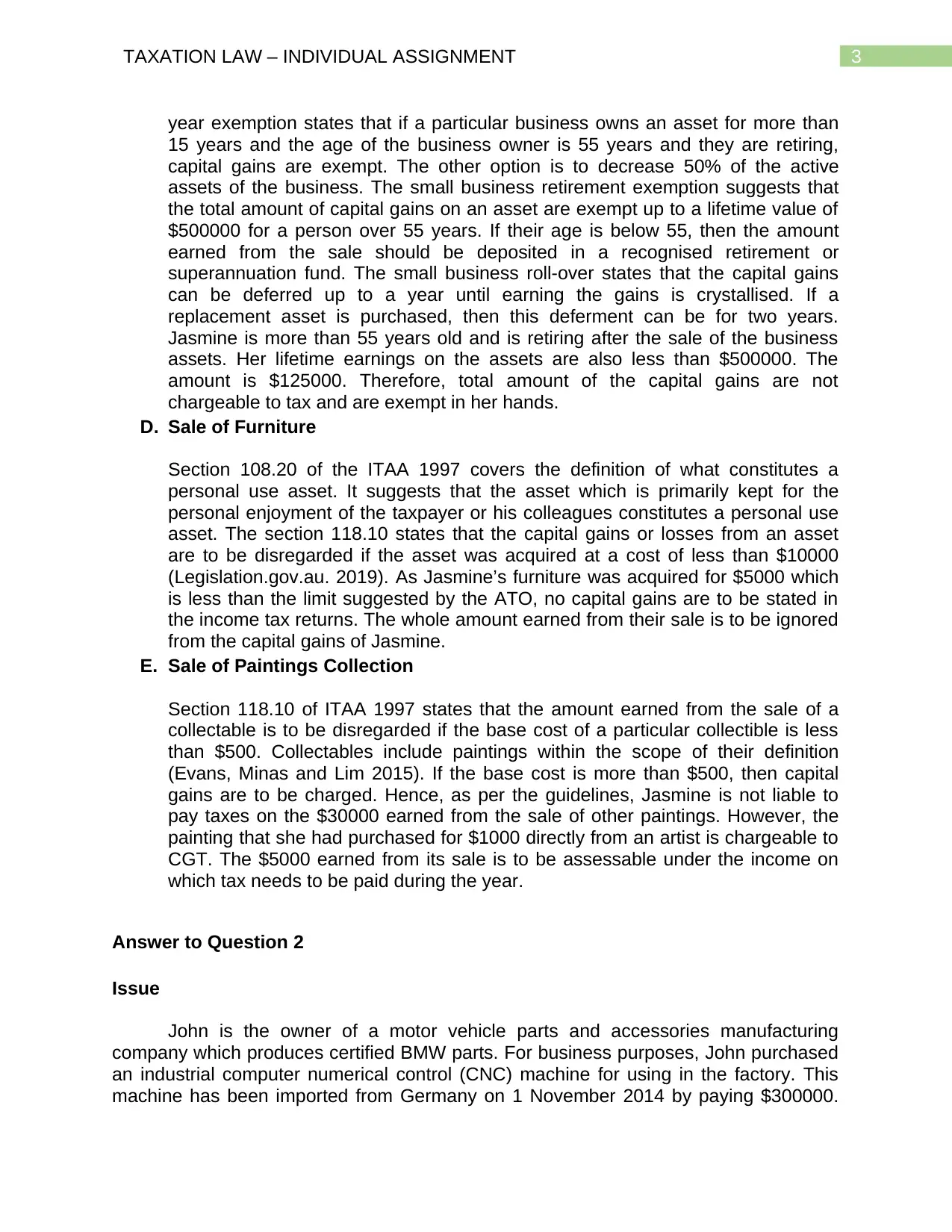
3TAXATION LAW – INDIVIDUAL ASSIGNMENT
year exemption states that if a particular business owns an asset for more than
15 years and the age of the business owner is 55 years and they are retiring,
capital gains are exempt. The other option is to decrease 50% of the active
assets of the business. The small business retirement exemption suggests that
the total amount of capital gains on an asset are exempt up to a lifetime value of
$500000 for a person over 55 years. If their age is below 55, then the amount
earned from the sale should be deposited in a recognised retirement or
superannuation fund. The small business roll-over states that the capital gains
can be deferred up to a year until earning the gains is crystallised. If a
replacement asset is purchased, then this deferment can be for two years.
Jasmine is more than 55 years old and is retiring after the sale of the business
assets. Her lifetime earnings on the assets are also less than $500000. The
amount is $125000. Therefore, total amount of the capital gains are not
chargeable to tax and are exempt in her hands.
D. Sale of Furniture
Section 108.20 of the ITAA 1997 covers the definition of what constitutes a
personal use asset. It suggests that the asset which is primarily kept for the
personal enjoyment of the taxpayer or his colleagues constitutes a personal use
asset. The section 118.10 states that the capital gains or losses from an asset
are to be disregarded if the asset was acquired at a cost of less than $10000
(Legislation.gov.au. 2019). As Jasmine’s furniture was acquired for $5000 which
is less than the limit suggested by the ATO, no capital gains are to be stated in
the income tax returns. The whole amount earned from their sale is to be ignored
from the capital gains of Jasmine.
E. Sale of Paintings Collection
Section 118.10 of ITAA 1997 states that the amount earned from the sale of a
collectable is to be disregarded if the base cost of a particular collectible is less
than $500. Collectables include paintings within the scope of their definition
(Evans, Minas and Lim 2015). If the base cost is more than $500, then capital
gains are to be charged. Hence, as per the guidelines, Jasmine is not liable to
pay taxes on the $30000 earned from the sale of other paintings. However, the
painting that she had purchased for $1000 directly from an artist is chargeable to
CGT. The $5000 earned from its sale is to be assessable under the income on
which tax needs to be paid during the year.
Answer to Question 2
Issue
John is the owner of a motor vehicle parts and accessories manufacturing
company which produces certified BMW parts. For business purposes, John purchased
an industrial computer numerical control (CNC) machine for using in the factory. This
machine has been imported from Germany on 1 November 2014 by paying $300000.
year exemption states that if a particular business owns an asset for more than
15 years and the age of the business owner is 55 years and they are retiring,
capital gains are exempt. The other option is to decrease 50% of the active
assets of the business. The small business retirement exemption suggests that
the total amount of capital gains on an asset are exempt up to a lifetime value of
$500000 for a person over 55 years. If their age is below 55, then the amount
earned from the sale should be deposited in a recognised retirement or
superannuation fund. The small business roll-over states that the capital gains
can be deferred up to a year until earning the gains is crystallised. If a
replacement asset is purchased, then this deferment can be for two years.
Jasmine is more than 55 years old and is retiring after the sale of the business
assets. Her lifetime earnings on the assets are also less than $500000. The
amount is $125000. Therefore, total amount of the capital gains are not
chargeable to tax and are exempt in her hands.
D. Sale of Furniture
Section 108.20 of the ITAA 1997 covers the definition of what constitutes a
personal use asset. It suggests that the asset which is primarily kept for the
personal enjoyment of the taxpayer or his colleagues constitutes a personal use
asset. The section 118.10 states that the capital gains or losses from an asset
are to be disregarded if the asset was acquired at a cost of less than $10000
(Legislation.gov.au. 2019). As Jasmine’s furniture was acquired for $5000 which
is less than the limit suggested by the ATO, no capital gains are to be stated in
the income tax returns. The whole amount earned from their sale is to be ignored
from the capital gains of Jasmine.
E. Sale of Paintings Collection
Section 118.10 of ITAA 1997 states that the amount earned from the sale of a
collectable is to be disregarded if the base cost of a particular collectible is less
than $500. Collectables include paintings within the scope of their definition
(Evans, Minas and Lim 2015). If the base cost is more than $500, then capital
gains are to be charged. Hence, as per the guidelines, Jasmine is not liable to
pay taxes on the $30000 earned from the sale of other paintings. However, the
painting that she had purchased for $1000 directly from an artist is chargeable to
CGT. The $5000 earned from its sale is to be assessable under the income on
which tax needs to be paid during the year.
Answer to Question 2
Issue
John is the owner of a motor vehicle parts and accessories manufacturing
company which produces certified BMW parts. For business purposes, John purchased
an industrial computer numerical control (CNC) machine for using in the factory. This
machine has been imported from Germany on 1 November 2014 by paying $300000.
Paraphrase This Document
Need a fresh take? Get an instant paraphrase of this document with our AI Paraphraser
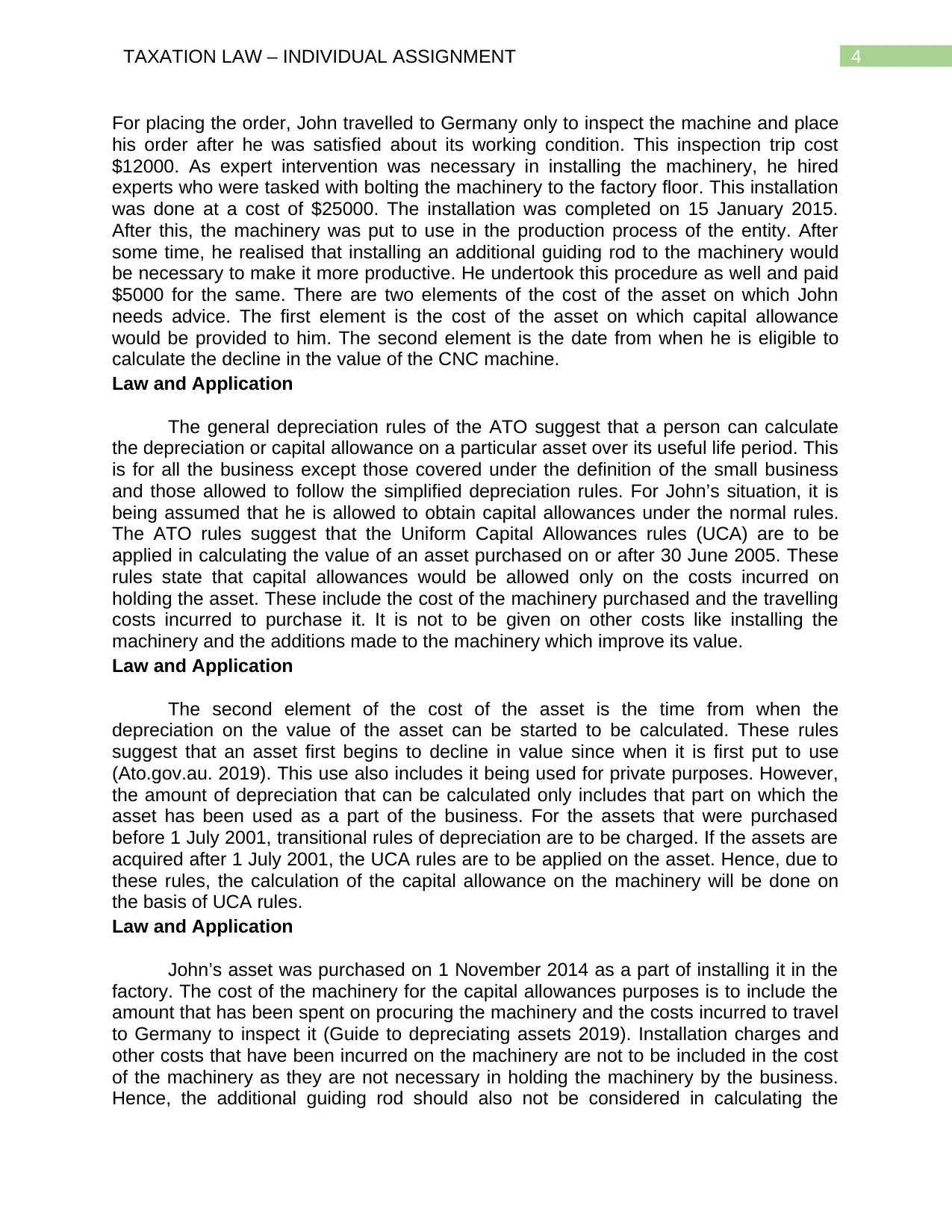
4TAXATION LAW – INDIVIDUAL ASSIGNMENT
For placing the order, John travelled to Germany only to inspect the machine and place
his order after he was satisfied about its working condition. This inspection trip cost
$12000. As expert intervention was necessary in installing the machinery, he hired
experts who were tasked with bolting the machinery to the factory floor. This installation
was done at a cost of $25000. The installation was completed on 15 January 2015.
After this, the machinery was put to use in the production process of the entity. After
some time, he realised that installing an additional guiding rod to the machinery would
be necessary to make it more productive. He undertook this procedure as well and paid
$5000 for the same. There are two elements of the cost of the asset on which John
needs advice. The first element is the cost of the asset on which capital allowance
would be provided to him. The second element is the date from when he is eligible to
calculate the decline in the value of the CNC machine.
Law and Application
The general depreciation rules of the ATO suggest that a person can calculate
the depreciation or capital allowance on a particular asset over its useful life period. This
is for all the business except those covered under the definition of the small business
and those allowed to follow the simplified depreciation rules. For John’s situation, it is
being assumed that he is allowed to obtain capital allowances under the normal rules.
The ATO rules suggest that the Uniform Capital Allowances rules (UCA) are to be
applied in calculating the value of an asset purchased on or after 30 June 2005. These
rules state that capital allowances would be allowed only on the costs incurred on
holding the asset. These include the cost of the machinery purchased and the travelling
costs incurred to purchase it. It is not to be given on other costs like installing the
machinery and the additions made to the machinery which improve its value.
Law and Application
The second element of the cost of the asset is the time from when the
depreciation on the value of the asset can be started to be calculated. These rules
suggest that an asset first begins to decline in value since when it is first put to use
(Ato.gov.au. 2019). This use also includes it being used for private purposes. However,
the amount of depreciation that can be calculated only includes that part on which the
asset has been used as a part of the business. For the assets that were purchased
before 1 July 2001, transitional rules of depreciation are to be charged. If the assets are
acquired after 1 July 2001, the UCA rules are to be applied on the asset. Hence, due to
these rules, the calculation of the capital allowance on the machinery will be done on
the basis of UCA rules.
Law and Application
John’s asset was purchased on 1 November 2014 as a part of installing it in the
factory. The cost of the machinery for the capital allowances purposes is to include the
amount that has been spent on procuring the machinery and the costs incurred to travel
to Germany to inspect it (Guide to depreciating assets 2019). Installation charges and
other costs that have been incurred on the machinery are not to be included in the cost
of the machinery as they are not necessary in holding the machinery by the business.
Hence, the additional guiding rod should also not be considered in calculating the
For placing the order, John travelled to Germany only to inspect the machine and place
his order after he was satisfied about its working condition. This inspection trip cost
$12000. As expert intervention was necessary in installing the machinery, he hired
experts who were tasked with bolting the machinery to the factory floor. This installation
was done at a cost of $25000. The installation was completed on 15 January 2015.
After this, the machinery was put to use in the production process of the entity. After
some time, he realised that installing an additional guiding rod to the machinery would
be necessary to make it more productive. He undertook this procedure as well and paid
$5000 for the same. There are two elements of the cost of the asset on which John
needs advice. The first element is the cost of the asset on which capital allowance
would be provided to him. The second element is the date from when he is eligible to
calculate the decline in the value of the CNC machine.
Law and Application
The general depreciation rules of the ATO suggest that a person can calculate
the depreciation or capital allowance on a particular asset over its useful life period. This
is for all the business except those covered under the definition of the small business
and those allowed to follow the simplified depreciation rules. For John’s situation, it is
being assumed that he is allowed to obtain capital allowances under the normal rules.
The ATO rules suggest that the Uniform Capital Allowances rules (UCA) are to be
applied in calculating the value of an asset purchased on or after 30 June 2005. These
rules state that capital allowances would be allowed only on the costs incurred on
holding the asset. These include the cost of the machinery purchased and the travelling
costs incurred to purchase it. It is not to be given on other costs like installing the
machinery and the additions made to the machinery which improve its value.
Law and Application
The second element of the cost of the asset is the time from when the
depreciation on the value of the asset can be started to be calculated. These rules
suggest that an asset first begins to decline in value since when it is first put to use
(Ato.gov.au. 2019). This use also includes it being used for private purposes. However,
the amount of depreciation that can be calculated only includes that part on which the
asset has been used as a part of the business. For the assets that were purchased
before 1 July 2001, transitional rules of depreciation are to be charged. If the assets are
acquired after 1 July 2001, the UCA rules are to be applied on the asset. Hence, due to
these rules, the calculation of the capital allowance on the machinery will be done on
the basis of UCA rules.
Law and Application
John’s asset was purchased on 1 November 2014 as a part of installing it in the
factory. The cost of the machinery for the capital allowances purposes is to include the
amount that has been spent on procuring the machinery and the costs incurred to travel
to Germany to inspect it (Guide to depreciating assets 2019). Installation charges and
other costs that have been incurred on the machinery are not to be included in the cost
of the machinery as they are not necessary in holding the machinery by the business.
Hence, the additional guiding rod should also not be considered in calculating the
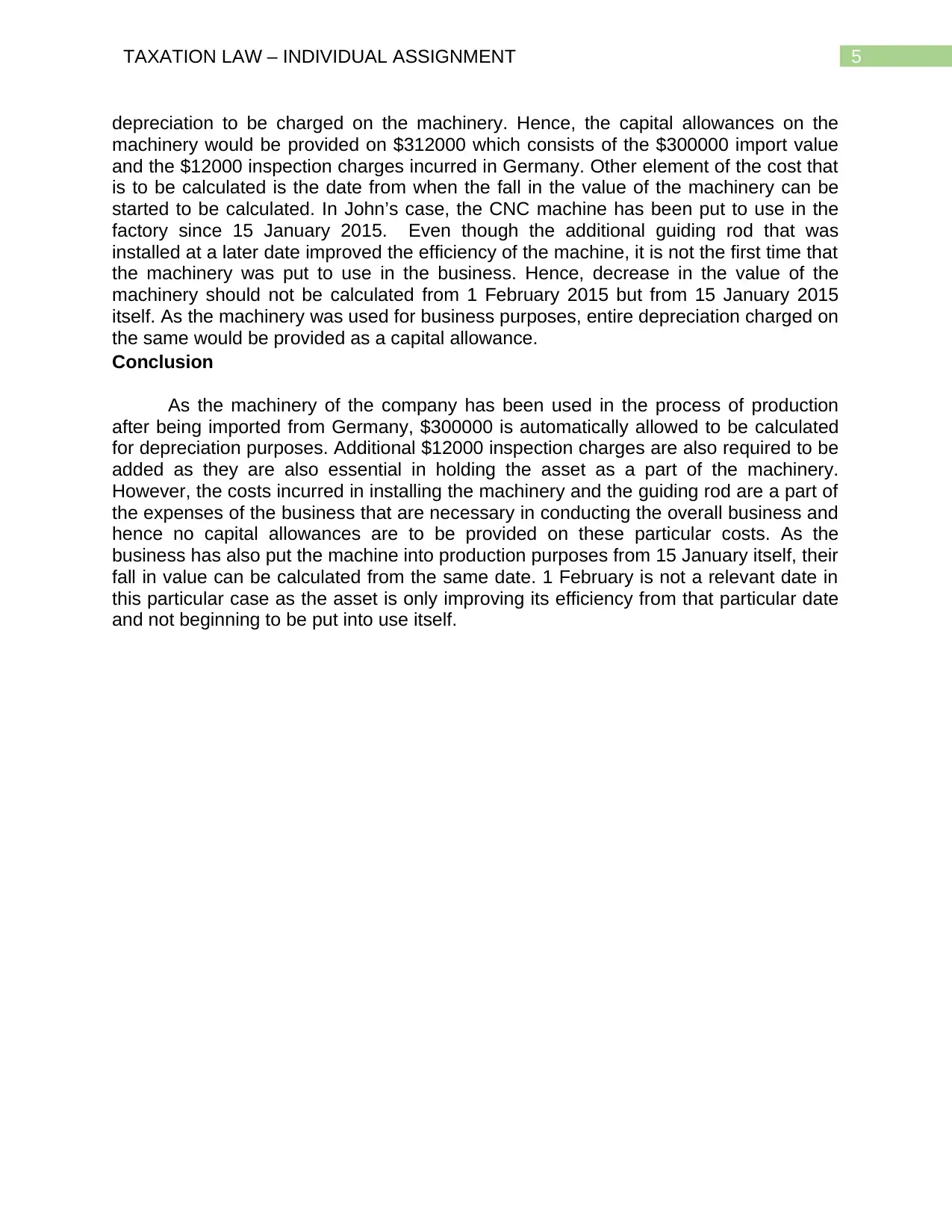
5TAXATION LAW – INDIVIDUAL ASSIGNMENT
depreciation to be charged on the machinery. Hence, the capital allowances on the
machinery would be provided on $312000 which consists of the $300000 import value
and the $12000 inspection charges incurred in Germany. Other element of the cost that
is to be calculated is the date from when the fall in the value of the machinery can be
started to be calculated. In John’s case, the CNC machine has been put to use in the
factory since 15 January 2015. Even though the additional guiding rod that was
installed at a later date improved the efficiency of the machine, it is not the first time that
the machinery was put to use in the business. Hence, decrease in the value of the
machinery should not be calculated from 1 February 2015 but from 15 January 2015
itself. As the machinery was used for business purposes, entire depreciation charged on
the same would be provided as a capital allowance.
Conclusion
As the machinery of the company has been used in the process of production
after being imported from Germany, $300000 is automatically allowed to be calculated
for depreciation purposes. Additional $12000 inspection charges are also required to be
added as they are also essential in holding the asset as a part of the machinery.
However, the costs incurred in installing the machinery and the guiding rod are a part of
the expenses of the business that are necessary in conducting the overall business and
hence no capital allowances are to be provided on these particular costs. As the
business has also put the machine into production purposes from 15 January itself, their
fall in value can be calculated from the same date. 1 February is not a relevant date in
this particular case as the asset is only improving its efficiency from that particular date
and not beginning to be put into use itself.
depreciation to be charged on the machinery. Hence, the capital allowances on the
machinery would be provided on $312000 which consists of the $300000 import value
and the $12000 inspection charges incurred in Germany. Other element of the cost that
is to be calculated is the date from when the fall in the value of the machinery can be
started to be calculated. In John’s case, the CNC machine has been put to use in the
factory since 15 January 2015. Even though the additional guiding rod that was
installed at a later date improved the efficiency of the machine, it is not the first time that
the machinery was put to use in the business. Hence, decrease in the value of the
machinery should not be calculated from 1 February 2015 but from 15 January 2015
itself. As the machinery was used for business purposes, entire depreciation charged on
the same would be provided as a capital allowance.
Conclusion
As the machinery of the company has been used in the process of production
after being imported from Germany, $300000 is automatically allowed to be calculated
for depreciation purposes. Additional $12000 inspection charges are also required to be
added as they are also essential in holding the asset as a part of the machinery.
However, the costs incurred in installing the machinery and the guiding rod are a part of
the expenses of the business that are necessary in conducting the overall business and
hence no capital allowances are to be provided on these particular costs. As the
business has also put the machine into production purposes from 15 January itself, their
fall in value can be calculated from the same date. 1 February is not a relevant date in
this particular case as the asset is only improving its efficiency from that particular date
and not beginning to be put into use itself.
⊘ This is a preview!⊘
Do you want full access?
Subscribe today to unlock all pages.

Trusted by 1+ million students worldwide
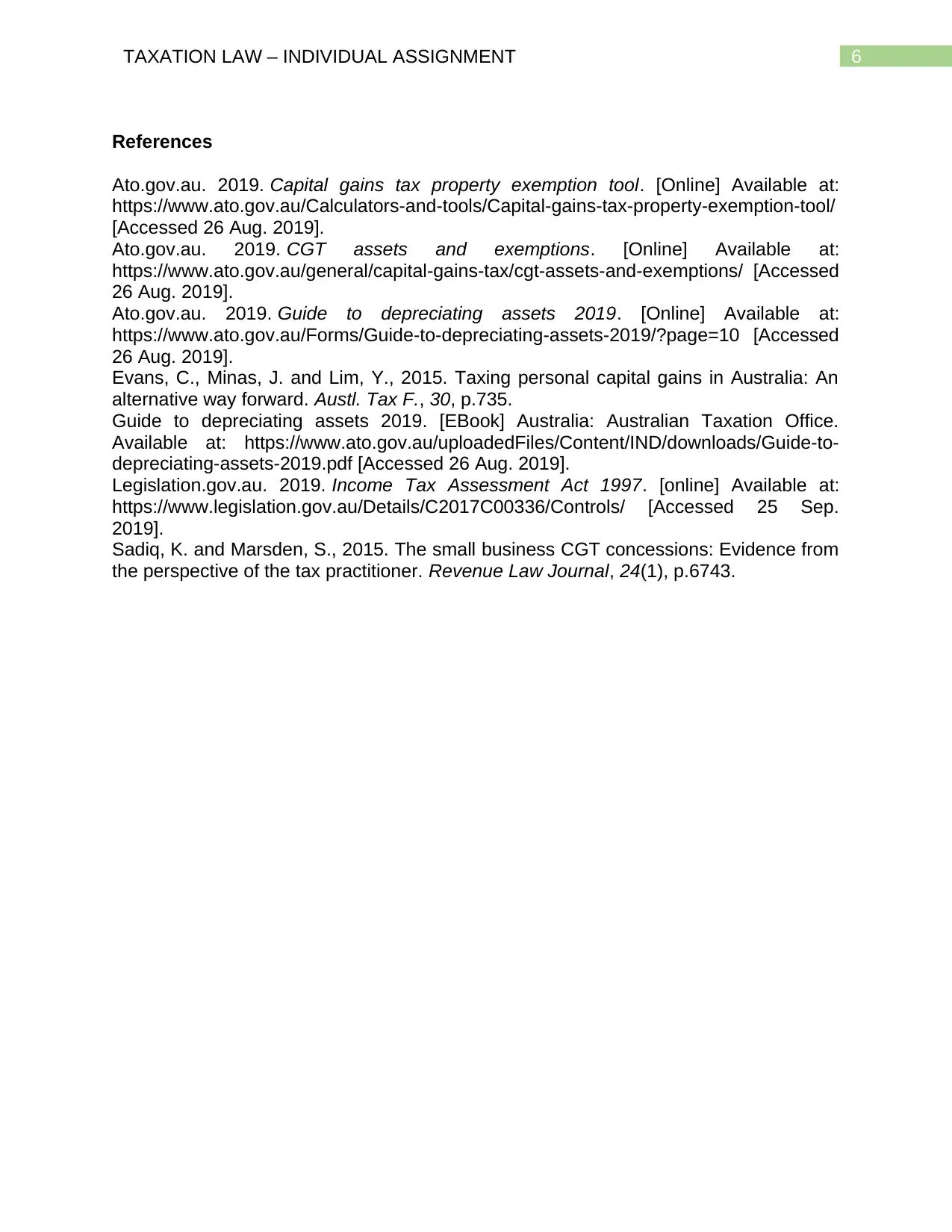
6TAXATION LAW – INDIVIDUAL ASSIGNMENT
References
Ato.gov.au. 2019. Capital gains tax property exemption tool. [Online] Available at:
https://www.ato.gov.au/Calculators-and-tools/Capital-gains-tax-property-exemption-tool/
[Accessed 26 Aug. 2019].
Ato.gov.au. 2019. CGT assets and exemptions. [Online] Available at:
https://www.ato.gov.au/general/capital-gains-tax/cgt-assets-and-exemptions/ [Accessed
26 Aug. 2019].
Ato.gov.au. 2019. Guide to depreciating assets 2019. [Online] Available at:
https://www.ato.gov.au/Forms/Guide-to-depreciating-assets-2019/?page=10 [Accessed
26 Aug. 2019].
Evans, C., Minas, J. and Lim, Y., 2015. Taxing personal capital gains in Australia: An
alternative way forward. Austl. Tax F., 30, p.735.
Guide to depreciating assets 2019. [EBook] Australia: Australian Taxation Office.
Available at: https://www.ato.gov.au/uploadedFiles/Content/IND/downloads/Guide-to-
depreciating-assets-2019.pdf [Accessed 26 Aug. 2019].
Legislation.gov.au. 2019. Income Tax Assessment Act 1997. [online] Available at:
https://www.legislation.gov.au/Details/C2017C00336/Controls/ [Accessed 25 Sep.
2019].
Sadiq, K. and Marsden, S., 2015. The small business CGT concessions: Evidence from
the perspective of the tax practitioner. Revenue Law Journal, 24(1), p.6743.
References
Ato.gov.au. 2019. Capital gains tax property exemption tool. [Online] Available at:
https://www.ato.gov.au/Calculators-and-tools/Capital-gains-tax-property-exemption-tool/
[Accessed 26 Aug. 2019].
Ato.gov.au. 2019. CGT assets and exemptions. [Online] Available at:
https://www.ato.gov.au/general/capital-gains-tax/cgt-assets-and-exemptions/ [Accessed
26 Aug. 2019].
Ato.gov.au. 2019. Guide to depreciating assets 2019. [Online] Available at:
https://www.ato.gov.au/Forms/Guide-to-depreciating-assets-2019/?page=10 [Accessed
26 Aug. 2019].
Evans, C., Minas, J. and Lim, Y., 2015. Taxing personal capital gains in Australia: An
alternative way forward. Austl. Tax F., 30, p.735.
Guide to depreciating assets 2019. [EBook] Australia: Australian Taxation Office.
Available at: https://www.ato.gov.au/uploadedFiles/Content/IND/downloads/Guide-to-
depreciating-assets-2019.pdf [Accessed 26 Aug. 2019].
Legislation.gov.au. 2019. Income Tax Assessment Act 1997. [online] Available at:
https://www.legislation.gov.au/Details/C2017C00336/Controls/ [Accessed 25 Sep.
2019].
Sadiq, K. and Marsden, S., 2015. The small business CGT concessions: Evidence from
the perspective of the tax practitioner. Revenue Law Journal, 24(1), p.6743.
1 out of 7
Related Documents
Your All-in-One AI-Powered Toolkit for Academic Success.
+13062052269
info@desklib.com
Available 24*7 on WhatsApp / Email
![[object Object]](/_next/static/media/star-bottom.7253800d.svg)
Unlock your academic potential
Copyright © 2020–2025 A2Z Services. All Rights Reserved. Developed and managed by ZUCOL.





